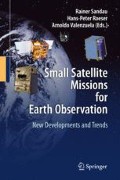Abstract
SPRITE-SAT is a micro satellite in the size of 50 cm cube and weighing 45-kg, designed and developed by Tohoku University. Its mission objective is to conduct scientific observation of atmospheric luminous emissions called “sprites” and terrestrial Gamma-ray flushes. Both are recently discovered phenomena and their mechanisms are still under the veil. SPRITE-SAT was developed to achieve significant observations to determine clear models of these mysterious phenomena. On January 23rd, 2009, SPRITE-SAT was successfully launched by JAXA’s H-IIA rocket as a piggyback payload of Greenhouse Gas Observation Satellite (GOSAT). The spacecraft is now in a sun-synchronous polar orbit with 670 km altitude form the Earth’s surface.
This chapter is also written by SPRITE-SAT Development Team.
Access this chapter
Tax calculation will be finalised at checkout
Purchases are for personal use only
References
Y. Sakamoto, K. Yoshida, E. Ujiie, Y. Takahashi, T. Sakanoi, K. Takiuchi, T. Sawakami, Y, Nakazato, S, Kondo. “Development of the Attitude Control System for Tohoku University SPRITE-SAT Using a New-Model Deployable Mast,” Proceedings of the 59th IAC (International Astronautical Congress), Glasgow, Scotland, UK, Sept. 29–Oct. 3, 2008, IAC-08.C1.8.14.
E. Ujiie, K. Yoshida, Y. Takahashi, Y. Sakamoto, T. Sakanoi, Y. Masumoto, Y. Kasaba, S. Kondo. “Development of SPRITE-SAT for TLE and TGF measurements,” IEICE (Institute of Electronics, Information and Communication Engineers), SANE2008-53, pp. 1–6.
R.C. Franz, R.J. Nemzek, J.R. Winckler. Television image of a large upward electrical discharge above a thunderstorm system. Science, 249(4964), 48–51, July 6, 1990.
SPACEWARN Bulletin No. 663, NASA, Feb. 1, 2009.
F. Bruhn, E. Lamoureux, G. Chosson, J. Bergman, K. Yoshida, T. George, R. Thorslund, J. Köhler. “Bridging the Space Technology Valley of Death: Two Spaceflights in 2009 to Validate Advanced MEMS/Microtechnology Systems and Subsystems,” CANEUS 2009 Workshop, NASA Ames, March 1–6, 2009.
Acknowledgement
This research is supported by Grant-in-Aid for Scientific Research No. 19002002, provided by Ministry of Education, Culture, Sports, Science and Technology (MEXT), Japan.
Author information
Authors and Affiliations
Corresponding author
Editor information
Editors and Affiliations
Rights and permissions
Copyright information
© 2010 Springer-Verlag Berlin Heidelberg
About this paper
Cite this paper
Takahashi, Y., Yoshida, K., Sakamoto, Y., Sakamoi, T. (2010). SPRITE-SAT: A University Small Satellite for Observation of High-Altitude Luminous Events. In: Sandau, R., Roeser, HP., Valenzuela, A. (eds) Small Satellite Missions for Earth Observation. Springer, Berlin, Heidelberg. https://doi.org/10.1007/978-3-642-03501-2_18
Download citation
DOI: https://doi.org/10.1007/978-3-642-03501-2_18
Published:
Publisher Name: Springer, Berlin, Heidelberg
Print ISBN: 978-3-642-03500-5
Online ISBN: 978-3-642-03501-2
eBook Packages: Earth and Environmental ScienceEarth and Environmental Science (R0)

